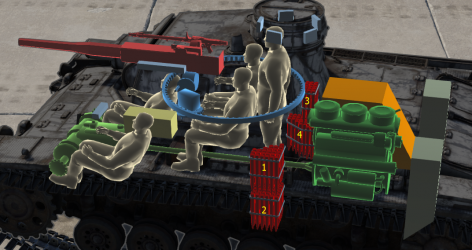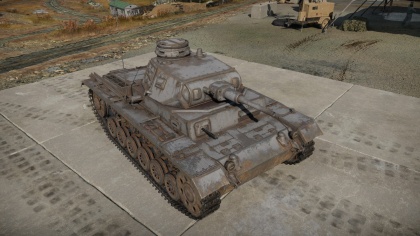Pz.III F
Contents
Description
The Pz.Kpfw. III Ausf. F (Panzer III Ausf. F) is a Rank I German medium tank with a battle rating of 2.0. It was introduced in during the Closed Beta Test for Ground Forces before Update 1.41. Compared to the Panzer III Ausf. E, the Panzer III Ausf. F presents a newer 5 cm KwK 38 main gun.
In game, Ausf. F modification differs from its predeccesor - Pz.III E mostly by its new 5 cm KwK 38 L/42 gun. While it doesn't offer that much more penetration than previous gun, and has a bit longer reload, it definitely causes more damage upon successful penetration. Other than that, only the turret armour has been enhanced a bit - most of the turret front armour is now 37mm thick (was 30mm). These changes makes the tank only slightly heavier, but the effect on mobility is negligible.
General info
Survivability and armour
Armour type:
- Rolled homogeneous armour
- Cast homogeneous armour (Cupola)
| Armour | Front (Slope angle) | Sides | Rear | Roof |
|---|---|---|---|---|
| Hull | 30 mm (11°) Front plate 25 mm (85°), 30 mm (53°) Front glacis 30 mm (22-72°) Lower glacis |
30 mm | 10 mm (74°), 20 mm (33-70°) Top 20 mm (11-66°) Bottom |
10 mm |
| Turret | 30 mm (14-30°) Turret front 37 + 37 mm (5-52°)Gun mantlet |
30 mm (17-26°) | 30 mm (0-23°) | 10 mm |
| Armour | Sides | Roof | ||
| Cupola | 30 mm | 10 mm |
Notes:
- Suspension wheels are 15 mm thick while tracks are 20 mm thick.
- The barrel shroud around the main gun is 20 mm thick.
- Bustle racks on the rear hull sides give another 30 mm thick armour at their locations.
- Belly armour is 15 mm thick.
Mobility
| Mobility characteristic | ||
|---|---|---|
| Weight (tons) | Add-on Armor weight (tons) |
Max speed (km/h) |
| 19.8 | N/A | 79 (AB) |
| 71 (RB/SB) | ||
| Engine power (horsepower) | ||
| Mode | Stock | Upgraded |
| Arcade | 465 | 572 |
| Realistic/Simulator | 265 | 300 |
| Power-to-weight ratio (hp/ton) | ||
| Mode | Stock | Upgraded |
| Arcade | 23.48 | 28.89 |
| Realistic/Simulator | 13.38 | 15.15 |
Armaments
Main armament
Give the reader information about the characteristics of the main gun. Assess its effectiveness in a battle based on the reloading speed, ballistics and the power of shells. Do not forget about the flexibilty of the fire, that is how quickly the cannon can be aimed at the target, open fire on it and aim at another enemy. Add a link to the main article on the gun: {{main|Name of the weapon}}. Describe in general terms the ammunition available for the main gun. Give advice on how to use them and how to fill the ammunition storage.
Ammo racks

| Full ammo |
1st rack empty |
2nd rack empty |
3rd rack empty |
4th rack empty |
Visual discrepancy |
|---|---|---|---|---|---|
| 99 | 75 (+24) | 50 (+49) | 25 (+74) | 1 (+98) | yes |
Turret empty: 50 (+49)
Additional armament
Some tanks are armed with several guns in one or more turrets. Evaluate the additional weaponry and give advice on its use. Describe the ammunition available for additional weaponry. Give advice on how to use them and how to fill the ammunition storage. If there is no additional weaponry remove this subsection.
Machine guns
Offensive and anti-aircraft machine guns not only allow you to fight some aircraft, but also are effective against lightly armoured vehicles. Evaluate machine guns and give recommendations on its use.
Usage in the battles
This tank should be played as a second line support or area denial vehicle, due to acceptable speed and accurate, potent gun, yet sluggish turret traverse even when fully upgraded. Avoid engagements at less than 500 meters, where your armour offers more protection against low-velocity guns and your 50mm cannon retains its penetration well. Always try to use the terrain to your advantage, you have very nice gun depression, so you will have no problem with attacking over hills and various obstacles, while hiding your vulnerable hull.
You should also refrain from directly attacking highest rank opponents you can meet (Like Sherman or T-34), your gun will struggle with their front armour a lot, while they often need a single shot anywhere to severely damage your tank.
Pros and cons
Pros:
- Accurate and decently powerful gun.
- Great gun depression.
- Very high APCR shell velocity (over 1000 m/s).
- Good mobility.
- Armour is fairly decent- will protect you against 37mm guns at range and 20mm cannon at all ranges if angled properly.
Cons:
- Awful turret traverse speed.
- Flat armour with little slope.
- Low reverse speed.
History
Development
The Panzerkampfwagen III medium tank, or the Panzer III was developed in the 1930s. Starting in early 1934, Heinz Guderian set down some specifications for a new tank, which Army Weapons Department took up to design the tank to weigh no more than 24,000 kilograms with a top speed of 35 km per hour. This tank's role was to be the main tank of the German army and was expected to destroy opposing tanks, as opposed as a tank made to destroy anti-tank guns and opposing infantrymen, which the Panzer IV took up in.
Damlier-Benz, Krupp, MAN, and Rheinmetall produced prototypes meeting the specifications and the Damlier-Benz model was chosen after testing in 1936-1937. The Panzer III model used a leaf-spring suspension in its early models (Ausf. A - Ausf. D) before utilizing a six-wheeled torsion-bar suspension in the Ausf. E and beyond. The Panzer III had a crew of five people, the commander, gunner, loader, driver, and assistant driver. The best feature of the Panzer III during its introduction that is the most overlooked was the three-man turret, which was not as common at the time. This frees the commander to be able to effectively command the tank while maintaining situational awareness rather than be burdened by the role of a loader or gunner, improving combat effectiveness of the tank. Despite this rather advance design, the turret did not have a turret basket for the crew. It was a proven design and production began in May 1937. The total number of Panzer IIIs tanks constructed in its production life was 5,774 units (excluding StuG III variant).
Specifications
The Panzer III Ausf. A through C had 15 mm of armour on all sides with 10 mm on top and 5 mm on the bottom. This was quickly upgraded to 30 mm on front, side, and rear on the Ausf. D, E, F, and G models. The Panzer III Ausf. F featured a 50 mm KwK 38 cannon, an upgrade over the previous 37 mm KwK 36. The Panzer Ausf. F had a 300 PS Maybach HL 120 TRM engine that gave it a top speed of about 40 km/h (25 mph) with a operational range of 155 km (96 mi.).
Combat Usage
The Panzer III Ausf. F was first prompted by the German army concerns of their tank-killing tank being undergunned during the French campaign, where the appearance of the French Char B1 and British Matilda tanks proved that their current arsenal was inadequate to counter these threats. Though it was initiated during the campaign, it was over before it could be fully implemented among the armoured forces. It wasn't until Operation Barbarossa, where the appearance of the Soviet T-34 and KV-1 tanks forced the Germans to take up better weapons for their anti-tank inventory. The solution was the 50 mm KwK 38, which helped the Panzer III be able to destroy these Soviet tanks with APCR rounds. Even though the newer Soviet tanks may put the Panzer III out of frontline duties, it still stayed as the more common Soviet T-26 and BT series light tanks were more easily destroyed by the Panzer III.
The German army continued to upgrade their Panzer III to keep them in service as long as possible. The Panzer III Ausf. H featured another 30 mm of armour applied to the original 30 mm of armour on the hull. The next significant upgrade was to the Panzer III Ausf. J, which featured a solid 50 mm of frontal and rear armour plating.
Media
Skins and camouflages for the "Panzer III Ausf. F" from live.warthunder.com.
Sights
Read also
Links to the articles on the War Thunder Wiki that you think will be useful for the reader, for example,
- reference to the series of the vehicles;
- links to approximate analogues of other nations and research trees.
ETC.
Sources
Paste links to sources and external resources, such as:
- topic on the official game forum;
- other literature.
| Germany medium tanks | |
|---|---|
| Pz.III | Pz.III B · Pz.III E · Pz.III F · Pz.III J · Pz.III J1 · Pz.III J1 TD · Pz.III L · Pz.III M · Pz.III N |
| Pz.IV | Pz.IV C · Pz.IV E · Pz.IV F1 · Pz.IV F2 · Pz.IV G · Pz.IV H · Pz.IV J · Pz.Bef.Wg.IV J |
| Pz.V | VK 3002 (M) · Panther A · Panther D · Panther F · Panther G · Ersatz M10 · Panther II |
| M48 upgrades | M48A2 G A2 · M48 Super |
| Leopard 1 | Leopard I · Leopard A1A1 · Leopard A1A1 (L/44) · Leopard 1A5 · C2A1 · Turm III |
| Leopard 2 | PT-16/T14 mod. · Leopard 2K · Leopard 2AV |
| Leopard 2A4 · Leopard 2 (PzBtl 123) · Leopard 2A4M · Leopard 2 PL · Leopard 2A5 · Leopard 2 PSO · Leopard 2A6 · Leopard 2A7V | |
| Trophies | ▀M4 748 (a) · ▀T 34 747 (r) |
| Other | Nb.Fz. · KPz-70 |
| USA | mKPz M47 G · M48A2 C |
| USSR | ◊T-72M1 |





